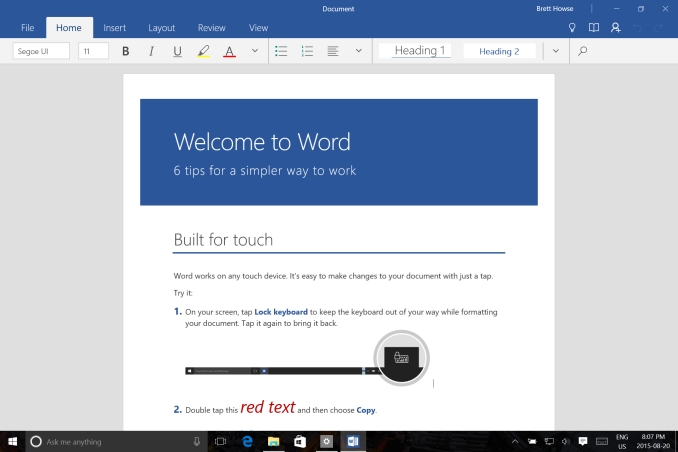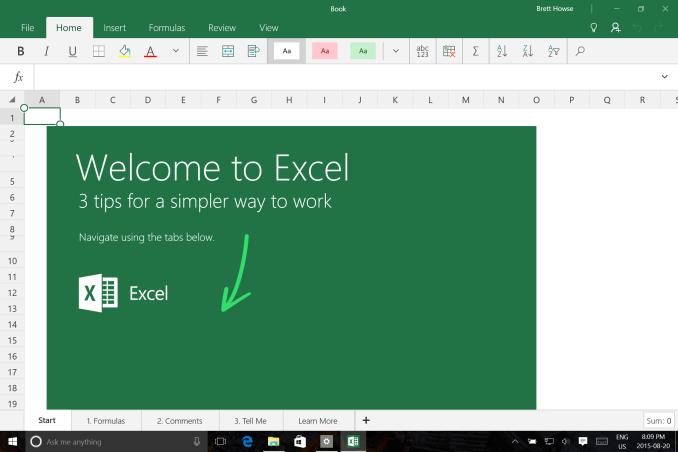The Windows 10 Review: The Old & New Face of Windows
by Brett Howse on August 25, 2015 8:00 AM EST- Posted in
- Operating Systems
- Microsoft
- Windows 10
Touch-Enabled Office Apps Arrive with Windows 10
When Windows 8 launched, Microsoft had built a touch-first version of their operating system, but they had not yet completed their touch-enabled version of their most popular productivity suite. In fact, in the almost three years between Windows 8 and Windows 10, Microsoft released Office on iOS first, and then Android, leaving their own platform as the only one without a touch-enabled version of Office. Finally, with Windows 10, Office Mobile is here.
These are, like practically all pieces of Windows 10, Windows Universal Apps, and therefore they are made to scale all the way from a phone to a large display desktop. Word, Excel, PowerPoint, and OneNote are all available. The experience is very similar to how it looks on the other platforms, and Microsoft has done a nice job keeping the look and feel consistent across the different mobile operating systems.
I think most people are familiar with the Office trio of Word, Excel, and PowerPoint, and perhaps not quite as familiar with OneNote, but the mobile apps are surprisingly competent versions, and can likely easily replace the full Office suite for a lot of people. If you need some of the extra functionality like conditional formatting in Excel, or the ability to open password protected documents, you will need to go with the full version of Office, at least for now.
In pretty typical Microsoft fashion, the apps have been created to allow basic file reading, creation, and editing for free, but if you want to access all of the features you need to purchase an Office 365 subscription. There is a big caveat here though. This only applies to devices under 10.1 inches in screen diameter. Anything larger than this requires a subscription to gain access to edit, which is a pretty big concession. According to Microsoft, they want to keep the free capabilities available for devices that are mostly used with touch, and the Office team feels this cut-off is 10.1 inches. Amazingly, the same company also sells a consumer version of their tablet line, the Surface 3, which is a 10.8 inch device and therefore over the cut-off. They do sell it with a one year subscription, but it’s a rather odd way to market the new Office Mobile apps.
There is also a new piece to the Office puzzle, which is called Sway. Luckily, like OneNote, Sway is free for all users. So what is Sway? It is an interactive storytelling app, and it lets you easily add some text and media, and it will create a sway for you. It’s very much a cloud based app, and you can share links to your sway to view or edit. Think of it like a simpler version of PowerPoint. Here is a sway as an example of what it can do.
OneNote is of course back, and this is Microsoft’s app which lets you do a lot more than just take notes. The touch version is changed from Windows 8, and it now fits in with the theme of the other Office Mobile apps. Fans of the Windows 8 version’s radial menu will be disappointed though since that has gotten the axe.
I think the capabilities of these apps are going to improve over time, but it is unlikely they will ever offer the full functionality of the desktop version of Office. They are targeted towards a different set of needs. It was certainly one of the key missing pieces of the Windows 8 era, so it is great that they have made their debut with Windows 10. Only OneNote is installed out of the box, and the other apps can be found in the store.














293 Comments
View All Comments
inighthawki - Tuesday, August 25, 2015 - link
Lol this image is so full of crap. Not only can you turn most of it off permanently (And yes, you can disable WU and WD from the services list and it will not start back up) but this image is so misleading. They even photoshopped an ad in the start menu on a setting that doesn't even exist in the RTM build... Come on, that's low. Mos tof the other things such as "tracking keystrokes and browsing history" for wbe browsing exist in Windows 7 and 8. Wi-Fi sense has been known to be blown way out of proportion. Telemtry has also been proven to only provide non-personal information. It collects stuff such as hardware configurations, statistical information like how often you click the start button, and machine crashes. Does this seriously worry you that Microsoft knows that "someone in the world" owns a MacBook pro and clicked the start button 8 times today?You're really just buying into a bunch of fearmongering by a bunch of people who just wanted excuses to continue using Windows 7. If you don't like Windows 10 or don't want to use it, that's fine, but don't cite these ultra poor excuses as the reasons why, as it shows you didn't actually look much further than the surface, and just jumped on the bandwagon.
Notmyusualid - Tuesday, August 25, 2015 - link
Thank you for your (what I believe is an incorrect opinion), but I HAVE EVERYTHING TURNED OFF, and my firewall logs STILL show encrypted packets going out to Microsoft - EVERYTIME I hit a key, and everytime I open a program.So even if somebody starts with a Microsoft Account, their data would be synced to MS, before many would realise what had happened.
There is absoultely nothing you can say that would make me believe that MS deserves access to my contacts. Those are private.
And no, I did not jump on any bandwagon, I did my own testing, came to similar conslusion as the picture stated, and yes, I will be continuing to use Win 7, as I do not like it.
Only Enterprise Editions can disable all modes of telemetry...
inighthawki - Tuesday, August 25, 2015 - link
Oh OK, so you saw encrypted packets going out... So I guess you decrypted them and looked at the content, then? Sending information when certain types of hardware interrupts occur does not mean they are sending personal information or recording your keystrokes like a keylogger. You have no way of knowing what's in the packets, yet you make assumptions that it's a privacy issue. Yet another example of someone pretending they're fully informed because they open up Wireshark and see some packets being sent over the network and "came to a conclusion" about what was really happening.minijedimaster - Tuesday, August 25, 2015 - link
Are you paid to have some shill answer for everything windows 10? "Oh well, so you proved me wrong with your firewall packet captures, but do you REALLY know what it's sending???"LOL, yeah ok... go be a paid shill somewhere else.
inighthawki - Tuesday, August 25, 2015 - link
Sorry if I'm not irrational/paranoid and don't jump to conclusions based on evidence that doesn't actually show any of the claims you're making.Oh no, a network packet! My entire life must now belong to Microsoft's hands!
SlyNine - Tuesday, August 25, 2015 - link
I have to disagree. Your computer sending encrypted packets to Microsoft, even tho you supposedly disabled that stuff, is a HUGE red flag. At that point its up to Microsoft to convince me that they are NOT sending personal information (it shouldn't be sending any). I might have to pass on windows 10 until this gets clarification.imaheadcase - Wednesday, August 26, 2015 - link
Most modern windows OS send data to MS encrypted, almost all programs with internet connectivity do. The OP is prob just looking at the encrypted data it sends to check for windows updates. Has nothing to do with privacy.Holy hell did everyone just step on the jump to conclusions mat. lol
Notmyusualid - Friday, August 28, 2015 - link
It has everything to do with privacy.Every time I press a key, a packet is sent. This is not updates.
Notmyusualid - Friday, August 28, 2015 - link
It IS a Huge Red Flag.This guy is a Microsoft employee.
nikon133 - Sunday, August 30, 2015 - link
You sound like you might be working for competition, though. Apple? Some shady Linux brotherhood? Just saying.